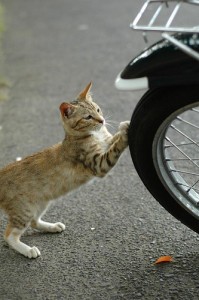5 Things to Look for in a Routine Tire Inspection
by Liz Jansen
One of the easiest proactive safety actions, is to conduct a routine tire inspection. There are only two tires and they’re all that is keeping you on the road.
 In my DIY (Do-It-Yourself) Maintenance Workshops, invariably participants show up with significantly low tire pressure and in some cases, damaged tires. On one occasion, the bike was towed home because the tire was unsafe to ride.
In my DIY (Do-It-Yourself) Maintenance Workshops, invariably participants show up with significantly low tire pressure and in some cases, damaged tires. On one occasion, the bike was towed home because the tire was unsafe to ride.
- Tire pressure. Check both tires when they’re cold. The recommended pressure is specified in the owner’s manual, sometimes on a sticker on your bike. They’re not always the same. The front tire will likely require less pressure than the rear. If you notice a sudden change, don’t just fill it up and continue. Find the root cause and make sure you’re not riding around on a damaged tire. (Note: This point was revised in response to the comment below.)
- Tread depth. Although the wear bars are good indicators, back that up by using a depth meter. They’re inexpensive and easy to use. Tires wear differently depending on the rubber compound, your riding style, the temperature and how well you keep them inflated.
- Wear patterns. Stand in front of the front tire and look for cupping or scalloping. Stand behind the rear and look for flat spots that develop with extended highway riding. If either are significant, you’ll need to replace the tire.
- Damage. Look for cuts, abrasions or embedded objects. The extent of the damage will determine whether the tire needs to be replaced. Don’t take chances.
- Tire age. This is important to check if you’re purchasing a used bike, used tires or discounted unused tires. Rubber degrades. It doesn’t matter if tires have been sitting on a shelf or on a bike. If they’re older than 6 years, they’re at risk of cracking or breaking down.Fortunately, there’s an easy check to determine their age. Find the DOT number on the sidewall. It will end with a four digit date stamp. The first two digits represent the week of manufacture; the last two the year. For example, if the last four digits are 1008, the tire was manufactured during the tenth week of 2008.
You put so much trust in your bike and there is so much at stake. Take a few minutes before each ride to do a brief visual inspection of your tires.
photo credit: cotaro70s via photopin cc

5 Things to Look for in a Routine Tire Inspection —
#1 the pressure imprinted on the sidewall of the tire is NOT “recommended pressure”. It is the pressure require to support the maximum load that the tire is rated for. Recommended pressure is found in the owner’s manual, and sometimes on a sticker on the bike.
Thanks Dan. You’re absolutely right. Thanks for calling it out. Liz